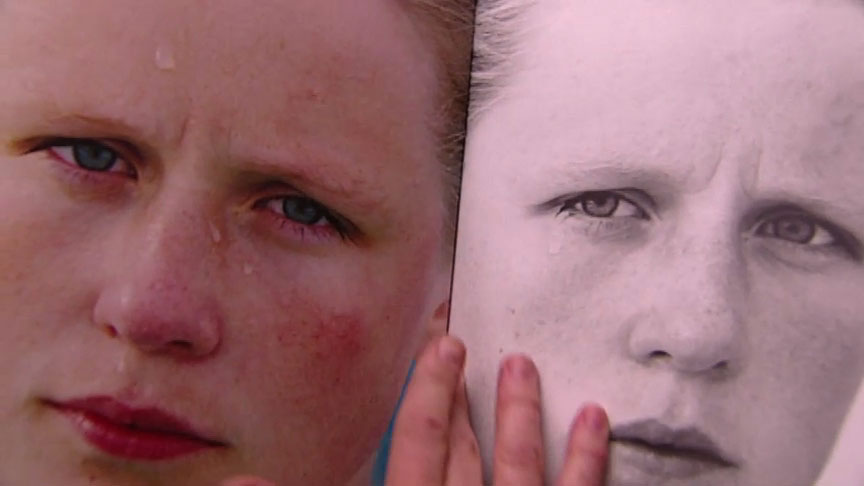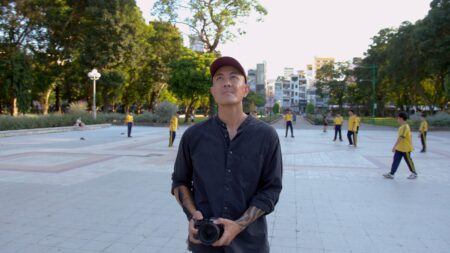Interview
Words and Pictures

Roni Horn. Agua Viva, detail, 2004. Installation view at Hauser & Wirth London, Piccadilly, United Kingdom, 2004. Production still from the Art in the Twenty-First Century Season 3 episode, Structures. © Art21, Inc. 2005.
Artist Roni Horn discusses the function of titles in her work, and the ways text, image, and sculpture work together in her installations.
ART21: Talk about titles.
HORN: There’s so much written about titles. I don’t like descriptive titles. I don’t like titles that—if you don’t read them, you don’t get the piece. I want a title that can be an entrance to something but never an explanation. A title is more about staying away from certain things but sort of showing you an entrance without naming it.
When I develop a title, it’s usually a critical part of thinking about the piece. It’s my way into the work. Sometimes (and I know this sounds kind of contradictory), it actually comes at the end. With Her, Her, Her, and Her, I’d gone through the experience of the piece, and the title came afterwards. With Becoming a Landscape, I had the title before I created the piece. I had the understanding of where I wanted to go, but I didn’t have the place where I was going.
ART21: What about the title Gurgles, Sucks, Echoes?
HORN: “Gurgles, sucks, echoes” was a phrase taken from a text I wrote. Those drawings were mostly just pictures of words. I don’t really think of them as visualizing the content of the word, necessarily, or the meaning of the word. It was just “gurgles, sucks, echoes”—pretty arbitrary, in a way—but a little bit about holding on to that phrase in my life. Every time I use that phrase, it’s like eating, like savoring something.

Roni Horn. Gurgles, Sucks, Echoes, 1992. Private Collection, Zurich. Photo by Bill Jacobson. Courtesy of Matthew Marks Gallery, New York.
ART21: How do text and sculpture function together in your work?
HORN: I often get questions about text pieces like Key and Cue. This type of work—where you’re supposedly in this visual realm and all of a sudden there is text—is not easy for a lot of people. I think of text as visual; but that, I think, is oddly Jewish. When you are brought up with the graven image as forbidden—because the graven image is a metaphor for a visualization—then it’s absolutely primary that language would replace that role. I never questioned it. It was only when I was asked about language in my work, in the finished object, that it became clear to me from a conscious level. I never really distinguished between symbolic visual language versus descriptive visual photograph. It’s pretty obscure, but I think there is some Jewish cultural element to that.
My relationship to my work is extremely verbal, extremely language-based. I am probably more language-based than I am visual, and I move through language to arrive at the visual. So, I’ve always questioned whether I am really a visual artist. You get into this situation where your identity takes over your actual being, because you get stuck with whatever it is you resemble to other people, not who you are. They’re not necessarily the same thing.
For example, Margret in You Are the Weather—that was fascinating because that was out of the context of this Iceland series. I did have a very specific idea: that I wanted to see if I could elicit a place from her face, almost like a landscape. It was very much a wordless interaction, the two months we spent together. When you do a portrait, it’s about mutual trust—that the person you’re working with trusts you, so that the image is fluent with whom she or he is.
There’s a story about Georgia that hits the nail on the head for me. She had seen You Are the Weather as a kid. I asked if I could photograph her. She was maybe five or six years old. She said, “Oh, Roni, you can take pictures, but you can’t show them.” I thought, “Wow, that’s interesting.” I let it go. And a couple of years later, she said, “Okay, Roni, you can.” I really just recorded her in action—a girl becoming a woman, trying on identities. That was very much her energy. It wasn’t orchestrated.

Roni Horn showing works from You are the Weather (1994–95) in her Manhattan studio, 2004. Production still from the Art in the Twenty-First Century Season 3 episode, Structures. © Art21, Inc. 2005.
ART21: What about the title of the piece with Georgia?
HORN: This is Me, This is You. Georgia didn’t give it to me; I took it from her. When she was very young, she used to look at pictures and point at different things in the picture. Kids do that. Like the dandelion—they’ll say, “This is me.” And then the rabbit—they’ll say, “This is you.” I just very much hooked into that. Every time she would come to visit me, we’d look at pictures, and she would pick herself out and pick me out.
ART21: Are there differences between the installation and book?
HORN: In the case of You Are the Weather, I originally went into that work thinking it was going to be part of this series of books. So, I knew whatever I came up with already had a frame around it, with a certain identity to it. When I started looking at all the material, it became clear to me that there was something else here that I wouldn’t be able to get at with a book form. That became the photographic installation, the experiential element.
What I like about photographic installation—and I think that what I do with photographic work is very much informed by having been a sculptor, meaning someone who works in the actual—is that you’re working with the image, which is the opposite of the actual. You’re working with the thing that you can peel off of something and still have the actual. That idea of image introduced into the actual was part of what I was questioning. You Are the Weather, which is a photographic surround, is definitely connected or linked up with the architecture—more or less synonymous with it—because it goes on all four walls. You walk in and you’re surrounded by up to a hundred images, which are one portrait of a person, who is a multitude. So, it comes in and goes back out. The viewer’s relationship to the portrait is very erotic because there is eye contact and ambiguity. And in my mind, the ambiguity is very much about the viewer—about what the viewer wants from the subject.

Roni Horn. This is Me, This is You, 1997–2000. Courtesy of Matthew Marks Gallery, New York.
ART21: What’s the rest of this piece about?
HORN: Identity in general, in a very broad sense—a moment-to-moment shift in image and identity. In a photograph, that shift in image is all you know from one sequence to the next sequence. I’m not saying that those are mutually exclusive identities, but little parts of a whole that the viewer brings on their own.
This interview was originally published on PBS.org in September 2005 and was republished on Art21.org in November 2011.



